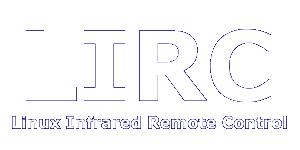|
|
Hardware related
-
Is my USB IrDA dongle supported by LIRC?
No, it's technically not possible to use USB IrDA
dongles (as specified by the Infrared Data Association) with LIRC. This does not apply to USB receivers in general.
-
Can I use my home-brew receiver and transmitter on
the same serial port?
Yes.
-
The value of the resistor in the receiver circuit
is labeled as '4k7' Ohm. Is this 4.7 Ohm, 4.7 kOhm
or what?
4k7 Ohm means 4700 Ohm. k is the abbreviation of
kilo.
-
Can I use a home-brew LIRC receiver with a Serial
to USB adapter?
No, this won't work. But there is a project
working on a dedicated USB
transceiver or you can connect an IR
receiver to a FTDI
based USB chip. Using an Irman with USB
adapter should work though.
-
I have a Hauppauge TV card. Can I use a different
remote control with this TV card except the
original Hauppauge remote control?
The Hauppauge remote control uses the RC-5
protocol. You should be able to use any TV remote
control that uses this protocol. Common brands
that use this protocol are Philips and
Marantz. A short description how to setup LIRC with an universal remote control was posted on the mailing list.
-
How do the drivers for the home-brew receivers
work? Do they use polling?
No, the serial port driver is fully interrupt
driven. On each edge of the IR signal the
interrupt handler is called and the time since the
last interrupt is calculated. As the parallel port
only generates interrupts on the rising edge of
the input signal, the parallel port driver uses
polling with the help of the hardware timer until
the signal becomes low again. As it is polling
only for microseconds this has no noticeable effect
on system performance.
-
I would like to connect an LCD display and an
home-brew IR receiver to the same serial
port. Will this work?
No, unless somebody writes a driver that merges
the functionality of the kernel serial port driver
and the lirc_serial driver. This is not
trivial.
-
I need a IR transmitter device to control my
TV/VCR/Settop box. But I'd rather buy a device than
solder my own.
Where can I buy LIRC compatible transmitters?
Check the driver documentation in the
configuration guide.
Here is several commercially available devices
including IrToy, IguanaIR and Tira.
-
I need a IR transmitter device to
control my TV/VCR/Settop box. But I'd
rather buy a device than
solder my own.
Where can I buy LIRC compatible
transmitters?
You can buy serial port or USB
transceivers at
www.irtrans.de.
They provide a LIRC compatible socket
interface.
Software setup
-
I have trouble to create a working lircd config file
for my remote. What can I do?
Please read the documentation about how to
add new remote controls.
-
Which kernel module do I have to load for my
hardware?
The documentation contains a detailed list
how to setup the various devices supported by
LIRC.
-
When I run irrecord or mode2 I get an error
message like this:
mode2: error opening /dev/lirc0
mode2: Device or resource busy
Another application is probably already accessing
/dev/lirc0. Only one process can use the device at
a time. You can find out which process uses the
device by calling (as root) fuser
/dev/lirc0.
-
Most of the time I have to push a button twice for
LIRC to recognize it. What's wrong?
The remote control probably uses the RC-5,
RC-6 or RECS80 protocol, but irrecord wasn't
able to recognize this correctly.
Try running irrecord
remotes/generic/RC-5.conf, irrecord
remotes/generic/RC-6.conf or irrecord
remotes/generic/RECS80.conf. You will
find these template config files inside the
LIRC source package. If this won't work read
this.
-
Every time I press a button on my remote control
irw will show at least 5 events (or any other
number > 1) independent of how short I try
pressing the button.
In most cases this is the correct behavior. Many
remote controls send the same code multiple times
to make sure that at least one code comes through
to the receiver when you press a button for a
short time. The default .lircrc setup ignores
repeat events. If you want to use the button to do
things repeatedly when it is being hold down, like
e.g. increasing the volume or something similar,
you should use the delay token (will be
available in 0.7.0) in your .lircrc file.
You can identify such remotes by the fact that
irrecord usually will add a min_repeat
field for this remote control to the lircd.conf
config file.
If you want to suppress those repeats
already at lircd level, you can also add
suppress_repeat x to the
lircd.conf config file where x is
the number of repeats you want to
suppress. This feature is available in lircd
since release 0.8.6.
-
Only root can run LIRC applications. When I run
LIRC applications (e.g. irexec) I get
this error message:
irexec: could not connect to socket
Check the permission of the lircd output socket,
usually /var/run/lirc/lircd. These permissions
are defined in lirc_options.conf, the
permissions option. You might need to
remove the device and restart lircd for this to
be effective.
Misc
-
I need a config file for <brand>
<device>. Do you have such a config
file?
If it's not on the website, then I don't have
it. Please don't ask me for config files.
-
Do you speak German?
Please only use English when sending emails.
-
Why didn't you answer my mail?
I get way more mails than I can handle. If you
don't get an answer to your question the
probability is very high that you will find the
answer in the documentation.
Mails about Total irRemote will go to /dev/null
unread.
HOWTOs
|
|



